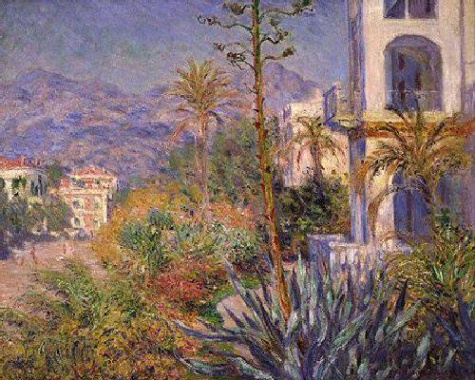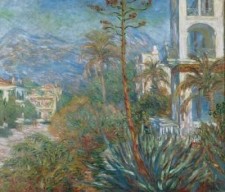
Claude Monet
French, 1840-1926
Villas in Bordighera, 1884
oil on canvas
45 1/4 X 51 1/4 in.
SBMA, Bequest of Katharine Dexter McCormick in memory of her husband, Stanley R. McCormick
1968.20.5

Claude Monet, Self-Portrait, 1886
'"For me, a landscape does not exist in its own right, since its appearance changes at every moment; but the surrounding atmosphere brings it to life – the light and the air which vary continually. For me, it is only the surrounding atmosphere which gives subjects their true value." - Claude Monet
RESEARCH PAPER
A viewer needs to take a few steps back when looking at Claude Monet’s VILLAS IN BORDIGHERA for the first time. A contemporary critic wrote, “If you stand too close to one of his canvasses, you are apt to see squiggles everywhere, or more accurately, piles of multicolored patches applied in broad brush work...his pictures demand distance.” (Smithsonian, P.90 ) Then, from this stepped-back view, we can ask ourselves how did Monet achieve such effects with but oil paint and vision? Biographers tell us he stood away from the canvas and often painted with a long-handled paintbrush, using both his multiple quick, short strokes of complimentary colors applied thickly, alternating with strong broad, blended brush strokes. It has also been said that his theory was that no object had a fixed color but rather he would render it simply by how the colors met his eyes as light struck it at a particular moment. That is, he tried to capture the beauty and truth of color minus thinking about what the actual colors were that “covered” the objects. What he sought to capture was the brilliant, “seductive, inebriating sunlight that performed magical tricks on the sky, rocks, walls, and lush semitropical vegetation” which he saw in this small Italian fishing village on the Italian Riviera in 1884. (ibid P. 83).
The sunlight was his real subject, and he portrayed it just as it appeared to him as it struck the landscape at that time of the day.The local viewer’s first impression of VILLAS IN BORDIGHERA frequently is, “It looks like it was painted in Santa Barbara.” There is great similarity between the painting and the local buildings, vegetation, and proximity to the mountains, and may have been what motivated Stanley McCormick to purchase it. Actually this painting was done in the gardens overlooking the Strada Romana, in Bordighera, Italy, the street which can be seen near the center of the left edge. The severe cropping of every side of the landscape is so typical of the artist’s style at that time. In the foreground is the upper portion of a powerful representation of a Century Plant in bloom with its tough, large vertical leaves painted in vibrant colors of blue, white and turquoise. Its bloom thrusts like a spear to the top of the canvas where its top is cropped off. This spear is mostly golden yellow and orange and divides the canvas in half. We know that Monet didn’t mix the colors on his palette, but rather placed thick short strokes of complimentary colors on the canvas and allowing the viewer’s eyes to unconsciously pull together the adjacent hues that ultimately give the appearance of shimmering sunlight. Even more, the artist had filled the shadows full of muted color.
To the right of, and just behind the Century Plant is the villa built about 1880 by Charles Garnier for Baron Raphael Bischoffsheim, known as the Villa Etelinda. Behind it is the Villa San’ Ampelio. The unorthodox cropping of the buildings and their reflecting so much light demands attention and draws the eye to them, giving strength and verticality to that portion of the painting. This nontraditional style of asymmetrical composition recalls a Japanese block print and resembles the style of Monet’s good friend Cezanne.
The viewers eyes are drawn to the left by the sequence of the tops of the palm trees across the middle ground of the painting and was the area that Monet met a major challenge. He said, “These damn palm trees are driving me crazy.”(ibid P88) The explosive fishbone leaf structures pushed the limits of his chromatic boundaries. These bronzed-green leaves of the treetops lead the eyes to the area of the center of the canvas where he created dynamic tension. He artfully introduced diagonal lines that surround a patch of lush growth in vibrant yellows, oranges, and greens beginning at the parched earthen street at the bottom left corner of the canvas and up toward the vertical lines on the right. In the distance, on the street there seem to be just a few figures, at least that’s what the squiggles appear to represent, and then the street disappears before another villa in the distance toward the upper left. In the background are the iridescent mauve mountains that provide the other diagonal lines as well as serving as the backdrop for this brilliantly lit village of Bordighera. Monet wrote his friend August Rodin, “In order to paint here one would need gold and precious stones.” (ibid, P84).
Indeed the jewel-like tones with which Monet painted this fishing resort village more than brought it to life on this spectacular canvas. Surely, it was Monet’s use of colors, light, brushstrokes, and his non-attention to convention, such as eliminating the typical vanishing point perspective, while emphasizing divergent spatial construction, that capture a sense of motion from the trees, leaves and other foliage, as they dominate the few man-made structures in the work. Again, this reveals Monet’s drive to catch the light and atmosphere via fast, bold brush strokes ( an influence from Delacroix), that is, to capture the moment, perhaps for the viewer to even see, feel and hear his view of Bordighera.
Also reflecting the often noted influence of Japanese prints, Monet used flat views and asymmetrical breaks of space to reinforce the particularity of the moment he sought to render.
Thus, the viewer is subtly drawn into this landscape to experience the sun-filtered garden and to eye-walk from the trees (as vertical shafts) to lush bunches of plants (as flat square clusters), whose mostly blue and green colors seem to vibrate from the brilliant Mediterranean light along the bright, sunlit Italian Riviera.
Because Monet “painted as a bird sings,” (Barnes, P 106), VILLAS IN BORDIGHERA is more than a painting of color and composition; it is rather an experience, as close to Monet’s own as he could create it--an atmosphere so exposed by Monet’s unique approach that it really fits the name so often associated with his paintings, “Impressionism.”
Provenance:
The Santa Barbara Museum of Art’s VILLAS IN BORDIGHERA may have been a model for a larger, nearly identical painting that Monet made for Berthe Morisot (now in a private collection in France.(Isaacson). It is one of a number of canvasses he painted during his visits to Bordighera in 1884. Jean Baptiste Faure purchased the (SBMA) painting from Monet in 1886. In 1894, he placed it with Durand-Ruel, Monet’s gallery representative, and finally it was sold to Stanley McCormick Nov. 4, 1896 while he was studying painting in Paris.
Bibliography:
Isaacson, Joel, CLAUDE MONET: Observation and Reflection, Oxford, 1978, Pg. 215, Smithsonian Magazine, July, 1997,
Stuckey, Charles F, MONET’S ART AND THE ART OF VISION, P. 108)
Barnes, Rachel, MONET BY MONET,Artists by Themselves,(ed) Knopf 1990, p106
Prepared for the SBMA Docent Council, November 2003 by Eunice Drell and Larry Johnson

The other Bordighera at Musee d'Orsay in Paris: Claude Monet (1840-1926), Villas at Bordighera, 1884, Oil on canvas, H. 115; W. 130 cm © RMN (Musée d'Orsay) / Hervé Lewandowski
COMMENTS
This painting is a brilliant demonstration of Monet's rediscovery of the Mediterranean during his stay in Italy in 1884. And yet it was painted in his studio in Giverny, from a smaller painting executed on the site (Villas in Bordighera, The Santa Barbara Museum of Art).
Monet intended to use the painting for a large decorative panel for Berthe Morisot's drawing room. Early in 1884, Morisot told her sister Edma: "I am starting to get close to my Impressionist friends. Monet is determined to give me a panel for my drawing room. You can imagine how pleased I am to accept it."
This work catches the bright light of the Mediterranean and the painter's fascination for the landscapes of this region. Here he has painted the garden of Mr Moreno, which he called "an earthly paradise" evoking "this property like none other […] a garden that resembles nothing else, it is a pure fantasy, all the plants in the world grow outside here and do not seem to be tended: it is a tangle of all the varieties of palm trees…" (to Alice Hoschedé, 5 February 1884).
Villas in Bordighera combines several typical features of Monet's art. First of all, it uses the large, almost square format, which he favored for his decorative work. Secondly, the repetition in the studio of a motif studied from nature at Bordighera presages his later ‘series'. Lastly, with this exotic landscape, Monet offers us a variation on one of his favorite themes—the garden.
http://www.musee-orsay.fr/en/collections/works-in-focus/painting/commentaire_id/villas-at-bordighera-
SBMA CURATORIAL LABELS
The 1880s were a decade of transition for Monet, both personally and professionally. In 1883, Monet began what would be a life-long partnership with Alice Hoschedé, the wife of one of his patrons, Ernest Hoschedé, who had abandoned his family following his bankruptcy several years earlier. The next year, Monet made his first trip to Bordighera on the French-Italian border, where he painted this ravishing view of a group of sun-drenched villas. Monet’s letters to Alice during this trip reveal his single-minded obsession with faithfully recording his visual sensations while painting outdoors and his constant frustration with his inability to capture quickly enough the explosion of color revealed by the brilliant but ever-changing Mediterranean light.
- Ridley-Tree Reinstallation, 2022
The 1880s were a decade of transition for Monet, both personally and professionally. In 1883, Monet began what would be a life-long partnership with Alice Hoschedé, the wife of one of his patrons, Ernest Hoschedé, who had abandoned his family following his bankruptcy several years earlier. The next year, Monet made his first trip to Bordighera on the French-Italian border, where he painted this ravishing view of a group of sun-drenched villas. Monet’s letters to Alice during this trip reveal his single-minded obsession with faithfully recording his visual sensations while painting outdoors and his constant frustration with his inability to capture quickly enough the explosion of color revealed by the brilliant but ever-changing Mediterranean light.
Van Gogh experienced a similarly ecstatic response to the resplendent Mediterranean light of Provence when he first began to paint outdoors in Arles in the early spring of 1888.
- Through Vincent's Eyes, 2022

When I told Loree Gold that I was going to be traveling through Northern Italy with a group of friends this fall, she mentioned that I should go to Bordighera, Italy, where Monet painted our painting, The Villas at Bordighera. I took a Xerox copy of our painting with me just in case I passed there and had time to look for the Villa. When driving down the Ligurian coast of Italy along the Mediterranean Sea, not far below Monte Carlo, I told the group that there was a mandatory stop in the town of Bordighera to find the villa in our painting.
The town is charming and beautiful, and unlike the nearby towns, it is a quiet town of stately homes that overlook the sea. Except for the facts that the homes were much older and that everyone spoke Italian, the weather and the plants were the same as in Santa Barbara. Fortunately it was a weekday and the City Hall was open. We wandered the halls until we found the head of Tourism. He was a young man who spoke little English. When I showed him the painting by Monet, he shook his head that he did not know. As we were about to leave he wrote down two names, Villa Garnier, and Villa Regina Margherita. He indicated that it was possibly one of these houses. He pointed that one was in one direction, and one in the other. We chose the Villa Margherita and began walking. About one quarter of a mile from the City Hall, the street was lined with large older homes behind fences and very tall plants. Along the way, there were three or four houses behind gates that looked similar to our painting, but they were just not right. I was about to give up the when I saw the Villa. I saw the brown band of writing above the first level, and knew it was the one. I later discovered that we were walking down the Via Roma, which is the same as the Strada Romana in Monet’s time.
The neighborhood was extremely quiet, the villa was pristine, and the plantings were very similar to the ones in the painting. There was a sign on the front pillar that seemed to say it was some sort of organization. The gates were open, so my friends and I walked in and tried to find the exact place that Monet stood to paint. The plants in the surrounding neighborhood are very tall, and block the mountains and houses in the distance, but from the side of the villa, through the trees, there was a little rise in the ground that was clearly the place where Monet painted. I stood there, looked at the Villa, and felt the victory one feels in solving a puzzle. After a minute or so, I felt a deeper excitement that I had somehow connected with an artist who had chosen to paint in this quiet garden in a town by the sea.
After the trip, with a little research, I read that the Bordighera was where the elite and royalty in Europe had their winter homes in the late 1800’s. Charles Garnier, who designed the Paris Opera House, moved to Bordighera and built himself a villa on the bluffs over the sea. In 1880, he was commissioned to build a villa by Baron Raphael Bischoffsheim, a wealthy German bachelor patron of the arts and sciences, who moved to Bordighera. He named it Villa Etelinda. (No one knows the reason it was named Etelinda, but the name is German, and means “noble one who protects her village). Many artists, scientists, and royalty visited the house that was famous for its gardens, and four years after it was built, Monet painted there.
In 2001, the French Minister of Culture reported that the French government had purchased a painting of The Villas at Bordighera for the Orsay museum. She reported that Monet painted it for Berthe Morisot in 1884, and that it was a very important painting as it represented a time when Monet’s palette was radically changing.
Queen Margherita of Italy, who was married to King Humberto I, visited the town of Bordighera in 1878, and was fascinated by the villas and gardens. After many long stays in Bordighera, and stays in the Villa Etelinda, Margherita purchased the villa. In 1914, she had a much larger villa built nearby. Today the Villa Etelinda is known as the Villa Regina Margherita of Savoia. Upon her death in Bordighera, her family, the Savoys, donated the villa to a national organization that cares for families who have lost soldiers, or who have been dispersed by wars.
I now look at our painting quite differently than I did before my trip.